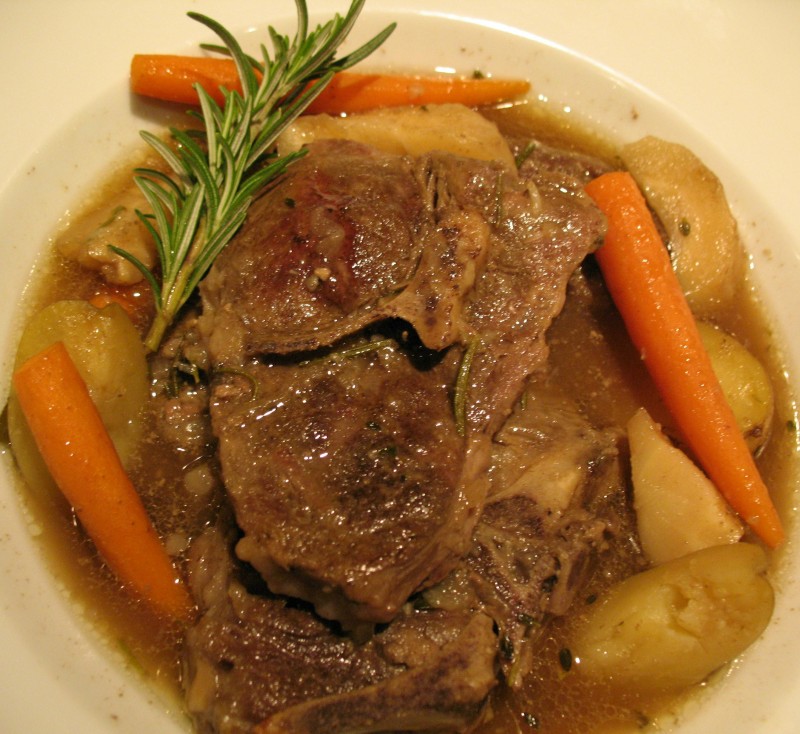Gavan Murphy on Irish Cuisine
 Most traditional Irish foods use simple, basic and cheap ingredients, a reminder of the fact that they originated in a less affluent past. Many have been given a modern twist by a new generation of chefs or incorporated into dishes that better suit the tastes of a more widely traveled population. Traditional Irish recipes tend to be very simple, with just a few ingredients in most cases. The main staples: meat, fish, dairy, potatoes, parsnips, cabbage, carrots, turnips, oats and barely.
Most traditional Irish foods use simple, basic and cheap ingredients, a reminder of the fact that they originated in a less affluent past. Many have been given a modern twist by a new generation of chefs or incorporated into dishes that better suit the tastes of a more widely traveled population. Traditional Irish recipes tend to be very simple, with just a few ingredients in most cases. The main staples: meat, fish, dairy, potatoes, parsnips, cabbage, carrots, turnips, oats and barely.
Traditional Irish foods: leek & potato soup, brown or white soda bread, Irish stew, colcannon, champ, barm brack, bacon & cabbage, mince pies.
 Irish stew is Irish stew only if using lamb or mutton (less tender sheep over a year old; it is fattier and more flavorful). Using any other meat is not considered an authentic Irish stew.
Irish stew is Irish stew only if using lamb or mutton (less tender sheep over a year old; it is fattier and more flavorful). Using any other meat is not considered an authentic Irish stew.
From the earliest times, bread making was (and still is) an integral part of daily life in almost every home. Soda bread dates back to circa 1840. Because the climate of Ireland hinders the growth of hard wheat (which creates a flour that rises easily with the assistance of yeast), buttermilk and bicarbonate of soda were the main raising agents in the past, which has never lapsed. Buttermilk is a great preservative, but more importantly it gives soda bread that beautiful tender crumb for which they are famous.
It was not a tradition to eat outside the home in Ireland other than at weddings or other special occasions until restaurants became common in the late 60’s or early 70’s. The offerings were dull – meat, vegetables and potatoes, stodgy flour & cream based sauces, with lots of frying. Anything that wasn’t fried to death was boiled to tastelessness. Vegetarians were offered an omelet. Traditional Irish food and diet, with a large emphasis on meat and butter, took the blame for the increasing obesity during this time.
Irish food and diet, with a large emphasis on meat and butter, took the blame for the increasing obesity during this time.
The biggest revolution in Irish restaurant food began in the early 1990’s and two women must take a great deal of credit for it – Myrtle and Darina Allen, of Ballymaloe House in County Cork. What they did sounds simple – took the freshest and best of Irish ingredients and prepared them with a minimum of fuss. What a change! The quality of the ingredients were key – meat reared on grass, vegetables eaten the day  they were picked, fish direct from the sea.
they were picked, fish direct from the sea.
Once the cookery school was established at Ballymaloe, this style of cooking spread throughout the country and is still a major influence on how the Irish eat today, both in restaurants and at home. This is where I trained as a chef and where my journey in ‘healthifying’ foods began. Though the Irish are very much still a butter and cream society, people are becoming more health conscious and selective in their eating habits.

IRISH STEW
By Gavan Murphy
Although I have kept the original ingredients, I have put my own spin on the style and presentation of the dish. That’s the beauty about cooking, you can take traditional dishes and make them your own.
Ingredients
3 lbs. Lamb shoulder 3 large parsnips – peeled & sliced ¼" rounds
½ lb. baby carrots - washed 3 garlic cloves – peeled
1 lb. mini potatoes – halved 1 Bouquet garni – rosemary, thyme, bay leaf
1 cup white wine 7 cups beef broth
olive oil S&P (to taste)
Method Preheat oven to 400F/200C. Begin by preheating a heavy bottomed sauté pan on high heat for 3-4 minutes. Add in 2 tbsp olive oil. Season lamb with S&P and sear in hot pan for 3-4 minutes on each side until golden brown. Remove to large roasting tray.
Preheat oven to 400F/200C. Begin by preheating a heavy bottomed sauté pan on high heat for 3-4 minutes. Add in 2 tbsp olive oil. Season lamb with S&P and sear in hot pan for 3-4 minutes on each side until golden brown. Remove to large roasting tray.
De-glaze sauté pan with white wine for 1 minute and scrape all carmelized bits from bottom. Add to lamb along with bouquet garni, garlic and broth. Cover with foil and place in oven for 1½ hrs.
Once initial cooking time has elapsed, reduce oven temperature to 375F/190C.
Add vegetables to stew (baby carrots, parsnips and mini potatoes), cover and return to oven at lower temp for additional hour or until veg are fully cooked and meat begins to fall off the bone. Taste and season with salt and pepper to desired taste.
NOTE: Never season your gravy before braising meat. The saltiness of the dish will intensify too much over the long cooking period. It’s always best to season just before serving.
 Elaine’s Healthy Gourmet Irish Soda Bread
Elaine’s Healthy Gourmet Irish Soda Bread
* I recommend you make this a day ahead.
Ingredients
1 cup oats, (they need to be quick cooking)
1 ½ cups of stone ground whole wheat flour
1/4 cup Turbinado (natural cane sugar)
1 T baking powder
1 ½ tsp salt
2 cups, plus, unbleached all purpose flour
1 tsp baking soda
3/4 stick butter (or margarine)
2 tsp caraway seeds (add an extra one if you like seeds)
1 ½ cups buttermilk (lowfat)
Method
Preheat your oven to 350 degrees. Put parchment paper on a cookie sheet. (If you don’t have parchment paper you can grease your cookie sheet.)
Combine whole wheat flour, oats, Turbinado, baking powder, salt, baking soda and unbleached flour in a large bowl. Cut the butter into the dry mixture until it is crumbly. Add the caraway seeds. Gradually stir in the buttermilk until the mixture is moistened, it will be sticky.
 On a very well floured surface, and with well floured hands, turn out the dough. Knead until it is mixed throughly (you may have to add additional unbleached flour) and form a ball. (If you want to make individual loaves, divide the dough into 6 balls. Cut a cross in the top of each loaf at least 1/4 inch to ½ inch deep.
On a very well floured surface, and with well floured hands, turn out the dough. Knead until it is mixed throughly (you may have to add additional unbleached flour) and form a ball. (If you want to make individual loaves, divide the dough into 6 balls. Cut a cross in the top of each loaf at least 1/4 inch to ½ inch deep.
Bake until a toothpick inserted comes out clean, 50-60 minutes. Let cool on wire rack.
To make this loaf even more gourmet you can add raisins and or nuts. Be sure that these additional ingredients do not exceed 1 ½ cups.
Serve warm with butter or one of Ireland’s creamy, rich cheeses.







